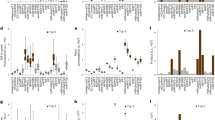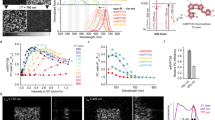Abstract
Two mutants of the green fluorescent protein (GFP), RSGFP4 and GFPS65T, have been recently created which differ from the wildtype GFP of A. victoria in their excitation maxima. Here we show that human fibroblasts transfected with either of the two mutant GFP genes emit a green fluorescence that is 18-fold brighter than the cells transfected with the wildtype GFP gene. Retroviral vectors expressing the improved GFP gene were also constructed to determine their suitability for stable gene transduction into mammalian cells. The inclusion of the RSGFP4 gene in a retroviral vector did not reduce the viral titer and resulted in a fluorescent signal in viable transduced cells detectable by both fluorescence microscopy and fluorescence-activated cell sorter (FACS) analysis. Therefore, the improved mutant GFP provides a vital marker for monitoring gene transfer and expression in mammalian cells.
This is a preview of subscription content, access via your institution
Access options
Subscribe to this journal
Receive 12 print issues and online access
$209.00 per year
only $17.42 per issue
Buy this article
- Purchase on Springer Link
- Instant access to full article PDF
Prices may be subject to local taxes which are calculated during checkout
Similar content being viewed by others
References
Chalfie, M., Tu, Y., Euskirchen, G., Ward, W.W., and Prasher, D.C. 1994. Green fluorescent protein as a marker for gene expression. Science 263(5148): 802–805.
Cody, C.W., Prasher, D.C., Westler, W.M., Pendergast, F.G., and Ward, W.W. 1993 Chemical structure of the hexapeptide chromophore of the Aequorea green fluorescent protein. Biochemistry 32(5): 1212–1218.
Inouye, S. and Tsuji, F.I. 1994. Aequorea green fluorescent protein. Expression of the gene and fluorescence characteristics of the recombinant protein. FEBS Lett. 341(2–3): 277–280.
Wang, S. and Hazelrigg, T. 1994 Implications for bed mRNA localization from spatial distribution of exu protein in Drosophila oogenesis. Nature 369(6479): 400–403.
Steams, T. 1995 Green fluorescent protein. The green revolution. Curr Biol. 5(3): 262–264.
Kitt, P., Adams, M., Kondepudi, A., Gallagher, D., and Kain, S. 1995 Green fluorescent protein (GFP): a novel reporter for monitoring gene expression in living cells and organisms. Clontechniques X(1): 1–2.
Marshall, J., Molloy, R., Moss, G.W., Howe, J.R., and Hughes, T.E. 1995 The jellyfish green fluorescent protein: a new tool for studying ion channel expression and function. Neuron 14(2): 211–215.
Delagrave, S., Hawtin, R.E., Silva, C.M., Yang, M.M., and Youvan, D.C. 1995 Red-shifted excitation mutants of the green fluorescent protein. Bio/Technology 13(2): 151–154.
Heim, R., Cubitt, A.B., and Tsien, R.Y. 1995 Improved green fluorescence. Nature 373(6516): 663–664.
Nolan, G.P., Fiering, S., Nicolas, J.-F., and Herzenberg, L.A. 1988. Fluorescence-cativated cell analysis and sorting of viable mammalian cells based on β-galac-tosidase activity after transduction of E. coli lacZ . Proc. Natl. Acad. Sci. USA 85: 2603–2607.
Cormack, B.P., Valdivia, R.H., and Falkow, S. 1996. FACS-optimized mutants of the green fluorescent protein (GFP). Gene. In press.
Hawley, R.G., Lieu, F.H.L., Fong, A.Z.C., and Hawley, T.S. 1994. Versatile retroviral vectors for potential use in gene therapy. Gene Therapy 1: 136–138.
Ghattas, I.R., Sanes, J.R., and Majors, J.E. 1991. The encephalomyocarditis virus internal ribosome entry site allows efficient coexpression of two genes from a recombinant provirus in cultured cells and in embryos. Mol. Cell. Biol. 11: 5848–5859.
Pear, W.S., Nolan, G.R., Scott, M.L., and Baltimore, D. 1993 Production of high-titer helper-free retroviruses by transient transfectiony. Proc. Natl. Acad. Sci. USA 90(18): 8392–8396.
Miller, A.D. and Buttimore, C. 1986. Redesign of retrovirus packaging cell lines to avoid recombination leading to helper virus production. Mol. Cell. Biol. 6: 2895.
Kotani, H., et al. 1994 Improved methods of retroviral vector transduction and production for gene therapy. Hum. Gene. Ther. 5(1): 19–28.
Author information
Authors and Affiliations
Rights and permissions
About this article
Cite this article
Cheng, L., Fu, J., Tsukamoto, A. et al. Use of green fluorescent protein variants to monitor gene transfer and expression in mammalian cells. Nat Biotechnol 14, 606–609 (1996). https://doi.org/10.1038/nbt0596-606
Received:
Accepted:
Issue Date:
DOI: https://doi.org/10.1038/nbt0596-606
This article is cited by
-
An efficient rapid system for assaying HBx-mediated transactivation
Biotechnology Letters (2017)
-
MAPK/ERK2 phosphorylates ERG at serine 283 in leukemic cells and promotes stem cell signatures and cell proliferation
Leukemia (2016)
-
Overexpression of ERG in cord blood progenitors promotes expansion and recapitulates molecular signatures of high ERG leukemias
Leukemia (2015)
-
Challenges and advances in mouse modeling for human pancreatic tumorigenesis and metastasis
Cancer and Metastasis Reviews (2013)
-
Tumor imaging with multicolor fluorescent protein expression
International Journal of Clinical Oncology (2011)



